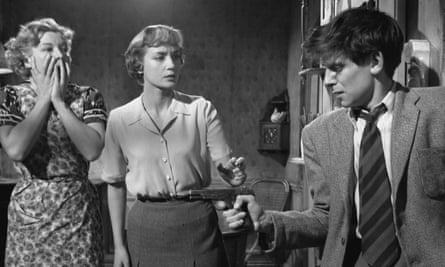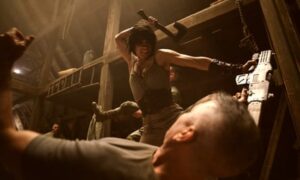J Lee Thompson is a British director who could maybe do with a bit more auteur respect: here is a double-bill rerelease of two of his early black-and-white films from the 1950s. The Weak and the Wicked (★★★★☆) is a melodrama that came out in 1954 just before his wrenching classic Yield to the Night, which featured Diana Dors on death row. It is a tough women’s prison film as well, one that quickly morphs into a social-issue sermon; it is richly flavoured, speckled with comic interludes and gloriously cast with Glynis Johns as Jean, a young society beauty and gambling addict whose dud cheque leads to an appearance in court and whose head-girl demeanour never falters in the clink. She becomes a good pal inside to brassy blond Betty Brown, played by Dors.
The movie is adapted by dramatist Anne Burnaby from the sensational autobiographical novel by the real-life upper class ex-con Joan Henry who also wrote the original source material for Yield to the Night. Henry married Thompson, helped him quit drinking and stayed with him through subsequent movies including Woman in a Dressing Gown, Ice Cold in Alex and The Guns of Navarone, until they divorced. (Startlingly, Burnaby was herself imprisoned in 1960 for stabbing a man with whom she had reportedly become obsessively infatuated.) Like the book, The Weak and the Wicked fudges the issue of Jean’s guilt by claiming that while she did bounce a cheque in a gambling club, the insurance fraud that got her arrested was an elaborate frame-up masterminded by the vengeful casino manager. It delivers the time-honoured frisson of the women’s prison film: hatchet-faced wardresses telling the new inmates to “strip”, with the scene subsequently held just long enough to let the audience think they are actually going to see something.
It also gives us some of the prisoners’ Ealing-esque backstories: blackmailers, shoplifters and one genuinely horrifying tale of a lonely woman who left her two young children alone in her flat to go dancing with a seedy gentleman admirer and returned at dawn to discover a ghastly tragedy. All these people are either weak or wicked; Jean is in her way claiming to be both or neither, and never explicitly says that the prison experience has cured her of gambling. It’s a rather buttoned-up British picture but with some gorgeous cameos from Rachel Roberts, Sybil Thorndike, Irene Handl, Sidney James, and, as Jean’s stern arresting officer, Ballard Berkeley, later to find immortality as Major Gowen in TV’s Fawlty Towers.

Thompson’s later film No Trees in the Street (★★★☆☆) from 1959 is bit less limber and more stage bound, a kitchen-sink crime thriller adapted by Dixon of Dock Green creator Ted Willis from his own play, and starring a young Melvyn Hayes as desperate teen tearaway Tommy, a mixed-up unhappy kid who gets involved in some bad business. The setting is a prewar slum in London’s East End, a place of much cockney backchat, warbling songs and screeching arias of despair, with news of Neville Chamberlain on the radio and graffiti about Oswald Mosley on the walls. It’s similar to, but more grim than the setting of Carol Reed’s A Kid for Two Farthings. Tommy lives with his gentle, beautiful sister Hetty (Sylvia Syms) and their mum (Joan Miller) in a cramped pair of rooms. Hetty and a local concerned copper Frank (Ronald Howard) are worried sick about Tommy, while the family’s cheeky mate Kipper (Stanley Holloway) is always coming round for a drink, singing and spinning tall tales about his former career in the music halls. He takes illegal street corner bets on behalf of brooding turf accountant Wilkie – played with magnificent menace by Herbert Lom – who is not-so-secretly involved in all sorts of mob crime.
Wilkie is in love with Hetty, who can see he’s no good. But will Wilkie simply wear her down with promises of the good life away from all this mess? The minute we see that poor, foolish Tommy has somehow got hold of a gun, it’s clear this is leading just one way: a colossal armed standoff with the police, led by grievingly upset Frank. In a later sequence Frank gives a huge ticking off to another kid, played by a young David Hemmings, who lives with his mum in the postwar high-rises that replaced the nasty slum and which, for all their faults, were a big improvement; they have trees in the street. It’s staged with robust panache, but under a proscenium arch.
Source: theguardian.com

















